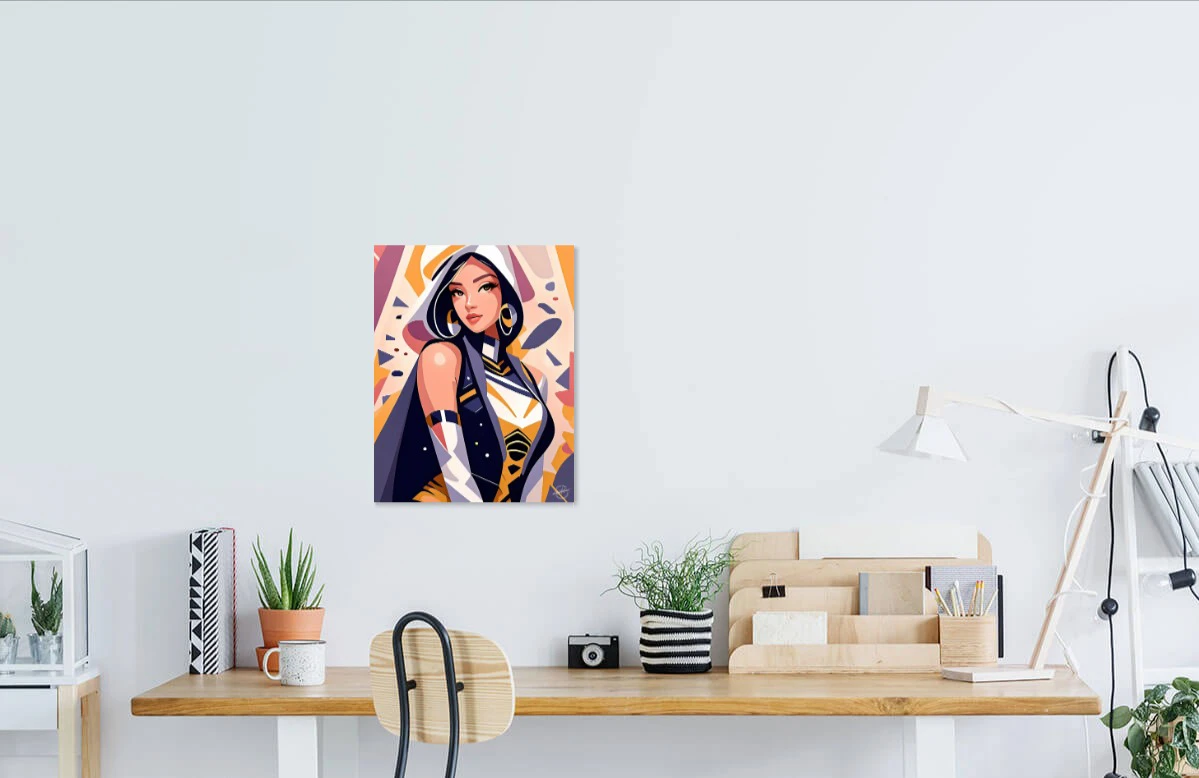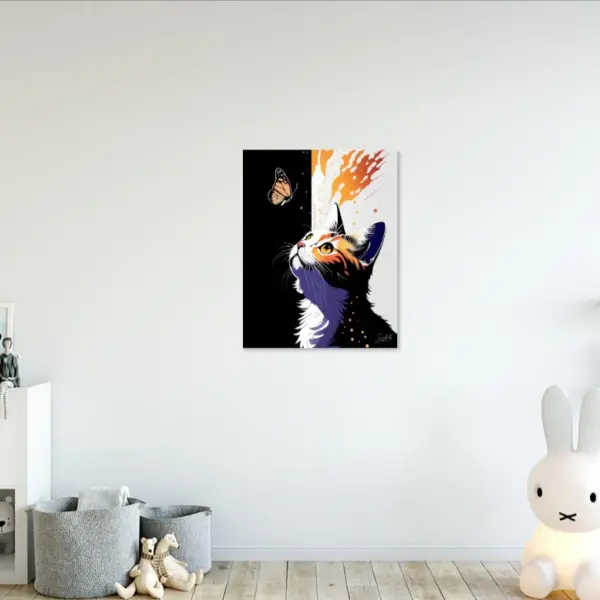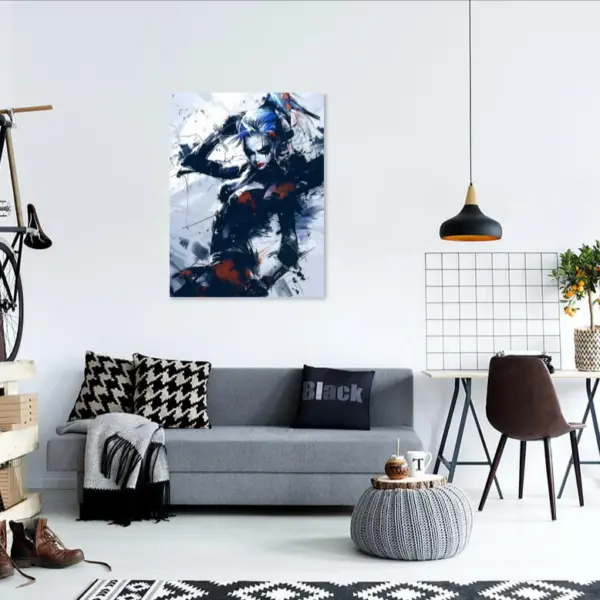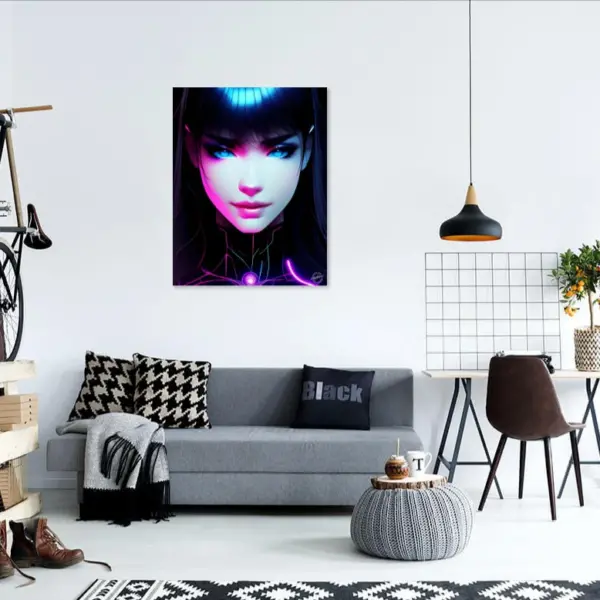I am fine
The figure in the painting is striking, both in her visual presence and the aura she projects. She stands tall, her posture composed and unapologetic. Her head is turned slightly, eyes meeting ours with a softness that hints at a quiet confidence. Yet, behind that poised expression, one senses layers of unspoken thoughts, emotions bubbling just below the surface. “I am fine,” she says, but there’s a duality here—the words echo both reassurance and deflection, a common refrain of someone who may carry more within than she chooses to share.
The woman’s attire is as much a part of her expression as her face. Dressed in an outfit that seems part warrior, part modern urban goddess, she exudes a powerful presence. The golden hues and dark blue tones, offset by the softer pinks and whites in the background, create a harmony of strength and warmth. The bold gold accents, reminiscent of armor, suggest a readiness to defend herself and her place in the world, while the softer tones in her face and expression invite connection and understanding. Her outfit is intricately designed, with layers of patterns and geometric shapes that catch the eye, drawing us in closer, encouraging us to notice every detail. The large gold hoops that adorn her ears frame her face like halos, giving her an almost regal quality, as if she is both a warrior and a queen, navigating her world with grace and resilience.
One cannot help but notice the hood she wears—a symbol that adds to the complexity of her character. The hood frames her face but also shields part of her identity. Is it an embrace of comfort, a retreat into herself, or a way to stand out in a crowd? Its stark contrast with her bright expression suggests that she carries her own personal weather—her own shelter against the elements of the outside world. It’s an intriguing choice, symbolizing the balance between showing oneself and remaining protected. The hood adds an element of mystique, as though she is constantly on the edge of revealing more but chooses to maintain control over what she shares.
Her expression, however, is the heart of the work. It’s the slight smile, that delicate curve of her lips, that brings the entire painting to life. There’s a playfulness in her eyes, an acknowledgment of the viewer, yet also a distance—like she knows something we don’t. Her eyes are wide and alert, filled with a quiet confidence. She seems to be telling the viewer, “I’m fine,” but whether that’s a complete truth or a carefully curated statement remains unclear. It’s this ambiguity that gives the painting its depth and complexity. It is as though she stands at the intersection of vulnerability and strength, simultaneously embodying both. The title, “I am fine,” could be read as a genuine statement or a surface-level mask, hinting at the emotional layers beneath.
The geometric shapes that surround her serve not only as decorative elements but as symbols of the fragmented, multifaceted nature of identity. The triangles, circles, and abstract forms give the composition an almost cosmic feel, as though she exists in her own universe, a place where everything is precisely designed, yet fluid and ever-changing. These shapes reflect the many roles she might play—daughter, friend, fighter, dreamer—all pieces of a whole that is constantly in flux. The background feels like a world of possibilities, not chaotic, but vibrant, representing the dynamic energy of the figure’s life.
The color palette of the painting is both bold and harmonious. The use of rich golds, dark blues, and soft pinks creates a sense of unity between the figure and her environment. These colors are both regal and grounded, giving her an air of authority but also accessibility. The warmth of the yellow-orange tones contrasts beautifully with the cool blues, symbolizing the dualities of passion and composure, fire and water, strength and tenderness. It’s this balance of opposing forces that defines her essence—she is neither one thing nor the other but a seamless blend of contradictions.
“I am fine” is not just a statement; it’s a conversation between the figure and the viewer. The more you look, the more you realize that the figure, though seemingly calm and composed, is layered with complexity. Her expression, her attire, the symbols around her—everything invites the viewer to look deeper, to ask questions about what lies beneath the surface. Is she truly fine, or is she saying what is expected of her? The painting doesn’t give a definitive answer, and that is its strength. It leaves room for interpretation, for the viewer to project their own emotions, their own understanding of what it means to declare, “I am fine.”
Ultimately, this piece celebrates the resilience and depth of the human spirit, particularly the female spirit. It acknowledges that while the exterior may appear composed, even serene, there is always more beneath the surface—strength, struggle, dreams, desires—all held together by the simple, yet profound, statement: “I am fine.”




 70-140cm (27.5″≈55″) Printable
70-140cm (27.5″≈55″) Printable

